Scooter Board Activities: 18 Sensory Play Ideas for Kids
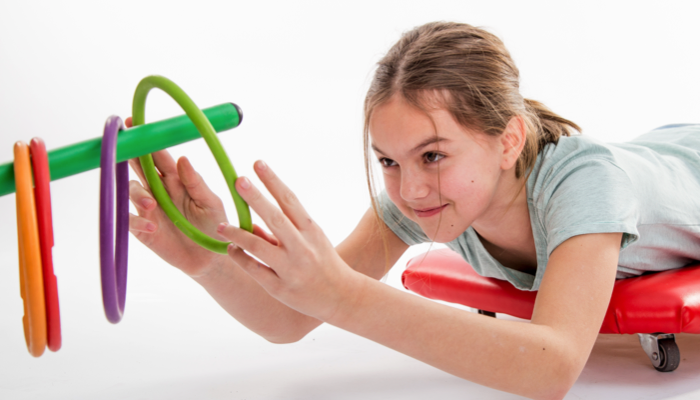
This post may contain affiliate links; please see our terms of use for details.
- A scooter board is a fun sensory toy and developmental tool often used by occupational therapists and teachers.
- These boards provide loads of sensory input – mainly vestibular and proprioceptive – responsible for your child’s balance, body awareness, and coordination.
- A scooter board provides many opportunities for your child to practice midline crossing, an essential developmental process by which the two sides of the brain learn to communicate.
- Scooter board activities strengthen your child’s core, upper body, hands, and legs. They provide cardiovascular exercise and increase your child’s physical endurance.
- Kids with sensory needs often find a scooter board an excellent way to regulate and self-soothe.
Scooter boards have been around for generations. You may remember them from your own elementary school days. They are a fun toy that encourages open-ended play, providing opportunities for strength training, improving balance, creativity, and abstract problem-solving.
There truly is no limit to the ways your child can play and create games with a scooter board. The sensory play ideas for kids we’ve compiled here will get you started by inspiring different types of sensory play to explore. Find the sensory experience your child enjoys most, and use that to cultivate a therapy fun zone for them to learn, grow, and play.
What Are Scooter Boards?
A scooter board is a small rectangular board with wheels attached to the bottom for your child to scoot around on. It’s like a wider skateboard, but its wheels turn in all directions. Some have a little cushion on top or handles to hold on to. They are often used in schools and by a pediatric occupational therapist as they have wonderful sensory input benefits.
What Are Scooter Boards Used For?
Scooter board activities are for everyone. They’re an excellent tool for kids with Sensory Processing Disorder, ADHD, and Autism. While a scooter board is not a quick fix for all your child’s sensory needs, it’s a great tool to have in your belt. Your child may also enjoy these sensory toys for toddlers or sensory toys for autism.
Scooter boards are loved for the limitless ways in which they aid in language development, critical thinking, gross motor skills, and sensory regulation. They are a powerful learning and developmental tool for all children, especially those who are sensory-seeking or highly sensitive.
Children who are sensory seekers feel most regulated and balanced when they receive vestibular (balance) and proprioception (body awareness) input, which scooter boards are known for.
There are two intentional ways to use a scooter board:
- To give your child the sensory input they’re seeking, e.g. regulation or soothing.
- To work on higher-level sensory integration to improve their sensory processing and help them learn to cope with stimulation.
Where to Find Scooter Boards
- GYM SCOOTERS FOR KIDS: Kids can scoot, glide, and roll around the room while building core strength and coordination on this scooter board. Colors may vary slightly.
- INDOOR GROSS MOTOR ACTIVITIES: Work on coordination while having fun! Children will have fun building gross motor skills. The hard plastic design is durable, bright, and easy-to-clean.
- FUN PLAYGROUND EQUIPMENT: It also has plastic wheels that won’t damage floors. The safety handles keep fingers safe and away from rolling wheels, while providing steering and control of the board.
- OCCUPATIONAL THERAPY TOYS: Choose between blue, purple, green, and the heavy-duty red model. Each scooter board measures approximately 16.50” x 11.25” x 3.75”.
Amazon is a reliable source for scooter boards like this one. You can also check online sensory retailers as well. Most brick and mortar stores like Target or Walmart don’t carry them regularly.
If you’re crafty, you can make a scooter board pretty easily. Check out this tutorial on YouTube to see how.
18 Scooter Board Activities for Kids
Before beginning any scooter board activities with your children, you must discuss safety. Explain to them that while scooter boards are fun to play with in many ways, there is one non-negotiable rule:
NO STANDING ON A SCOOTER BOARD, EVER.
Scooter boards are not skateboards, and standing on them is an accident waiting to happen. Most kids will try anyway, so it’s so important to talk about safety and supervise their play.
We’ve grouped these scooter board activities into categories based on how children will play with them: by kneeling, sitting, laying on their bellies, or on their backs, and finally some ways to play that don’t involve riding on the board at all.
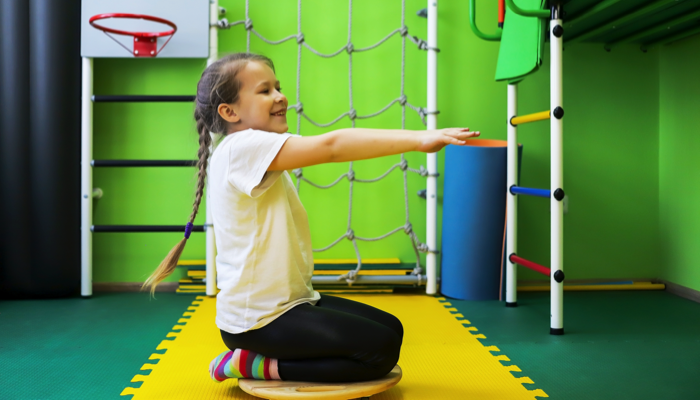
Activities to do While Kneeling
Kneeling on a scooter board is a great way to start because this position offers much more control and feels safer. Kneeling requires more co-contraction of your child’s core muscles because their center of gravity is higher. This works their ability to balance and stabilize their body while strengthening their trunk, hips, and shoulders.
- Object Toss: Have your child hold a bucket of objects like balls, rings, or bean bags, and use their other hand to pick them up and toss them at a target. Once they’ve hit the target, challenge them to move farther away or try from a different angle.
- Row the Boat: Using a stick like an ore, have your child push their “boat” around. Mark a voyage path with masking tape for them to follow.
- Table Ledge Crawl: Have your child grab onto a table or ledge and use their hands to walk along the edge and propel themselves around the perimeter. This encourages crossing of the midline, a hugely important developmental process directly linked to reading and learning skills.
Activities for Sitting
Sitting activities develop stability, posture, and co-contraction of the core muscles. An important note: the size of the scooter board makes a significant difference here. A larger board will provide more support. A smaller one will challenge your child’s balance.
- Ring/Bag Toss: Set up several cones or buckets along a path. Push your child along and see how they determine the timing and release of their bean bag based on the speed they’re traveling. If they miss, it’s the perfect opportunity for them to problem-solve and adjust their release on the next try.
- Sit and Scoot: Another exercise your child will naturally want to try. Sitting on the board and using their feet to push themselves along a path is an excellent core exercise and challenges them to stay balanced as their physical environment changes. This is an excellent opportunity to practice language development by giving them verbal commands, such as, “move three steps up, then turn left.”
- Timed Races: Mark a track with masking tape to follow and encourage them to beat their best time. Having a clear goal, like the timer, keeps them motivated.
- Delivery Service: Using a masking tape racetrack, set up buckets along the way and give your child objects they need to deliver on their route. Place stuffed animals along the path to receive the packages for extra fun.
- Duck and Weave: Challenge their spatial awareness (proprioception) by setting up a few cones and seeing if they can weave through them without knocking them down.
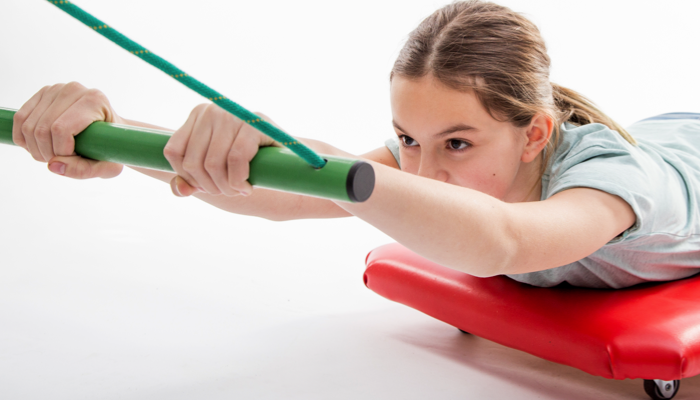
Activities for Laying on the Belly
After your child has done sitting or kneeling activities, encourage them to try exercises lying on their bellies to strengthen their back. The heavy work of self-propulsion in these prone positions provides a grounding sensation that many children find soothing.
- Walking Hands: Using two hands, one over the other, pull a rope to propel the board forward, developing your child’s bilateral coordination–strengthening the connection between the two halves of their brain. Grasping a rope strengthens your child’s grip, an important part of learning to feed themselves, hold a pencil, or swing from the monkey bars.
- Hand Scooting: While lying on the scooter board, have your child push themselves around using their upper body only. This facilitates proximal joint stability and improves the strength and mobility of their hands and upper extremities.
- Snake Track: Mark an “S” shaped track for your child to follow with tape. This is another exercise for crossing the midline and improving their coordination and neurological connectivity.
- Lay Down and Hold Tight: Have your child lay on their tummy and hold a rope while you, or a companion, pulls them around. This strengthens their grip and is especially fun because they get to interact with you, too.
- Puzzle Board: Set up an obstacle course with puzzle pieces at one end and the finished puzzle at the other. They will have to push themselves around to collect the pieces and deliver them to their final destination, where they will solve the puzzle. This stimulates your child’s cognitive development and problem-solving skills.
Laying on Their Back
Supine positions, laying on your back, are a great way to strengthen and stabilize your child’s core, hips, and legs.
- Self-Propelled: have your child lay on the back and pull themselves by grasping a rope that is tied to something (like a doorknob or play equipment). They can also keep their arms crossed and use their legs to push themselves.
- Pushing Off the Wall: In the same position mentioned above, have your child push off a wall and coast. See how far they can self-propell and then try to go further.
- The Train: Have your child grab hold of a rope or a hula hoop and you, or a friend, pull them around. Let them choose the path and encourage them to give clear directions for you to follow. Attach toy cars, a shopping cart, or anything else with wheels to make a train for the toys to ride around on.
Activities Off the Board
There are so many ways to play with a scooter board without having to mount or ride it, for children who are scared to sit or lay on top because of gravitational insecurity.
While you want to acknowledge and show respect to your child’s discomfort, a scooter board is a tool to gently push them towards tolerating more movement. They are less intense than a playground swing or slide and provide more control.
- Heavy Load Push and Pull: Have your child load up their scooter board with books or a box of heavy toys and push it around. If your scooter board has a handle, tie a rope to it and pull it, providing lots of proprioceptive input. You can even have your child pull a friend sitting on the scooter if they’re being safe.
This is an example of heavy work activity, a wonderfully beneficial tool for sensory-sensitive children to feel calm and self-regulate. You can find more calming or stimulating sensory activities here.
- Grading of Force: This activity is the companion to heavy work activities and also provides lots of proprioception and vestibular input. Have your child push themselves off a wall to knock down a tower of blocks. They will have to re-adjust their muscle movements and force based on whether they reached their target, were short, or overshot it. Use this as an opportunity to incorporate verbal skills and problem solving, by discussing if they reached their target and why or how they might be more successful if they used “more or less muscles” on the next try.
A scooter board is most fun when your child finds the type of sensory play that is engaging for them and allow themselves to explore. These boards create a unique therapy fun zone that kids love and will want to play with without even knowing the developmental benefits they’re receiving.
FAQs
Can Scooter Boards Be Used Outside?
Absolutely! Scooter boards are ideal for use outside on a flat surface. They don’t work as well indoors as they will only work on very thin carpeting or hardwood floors. You risk scratching up your floors if used indoors.
Are Scooter Boards Safe for Kids?
Scooter boards are just as safe as any other play equipment. Follow the cardinal rule: NO STANDING ON SCOOTER BOARDS and always supervise your children while they play with them.
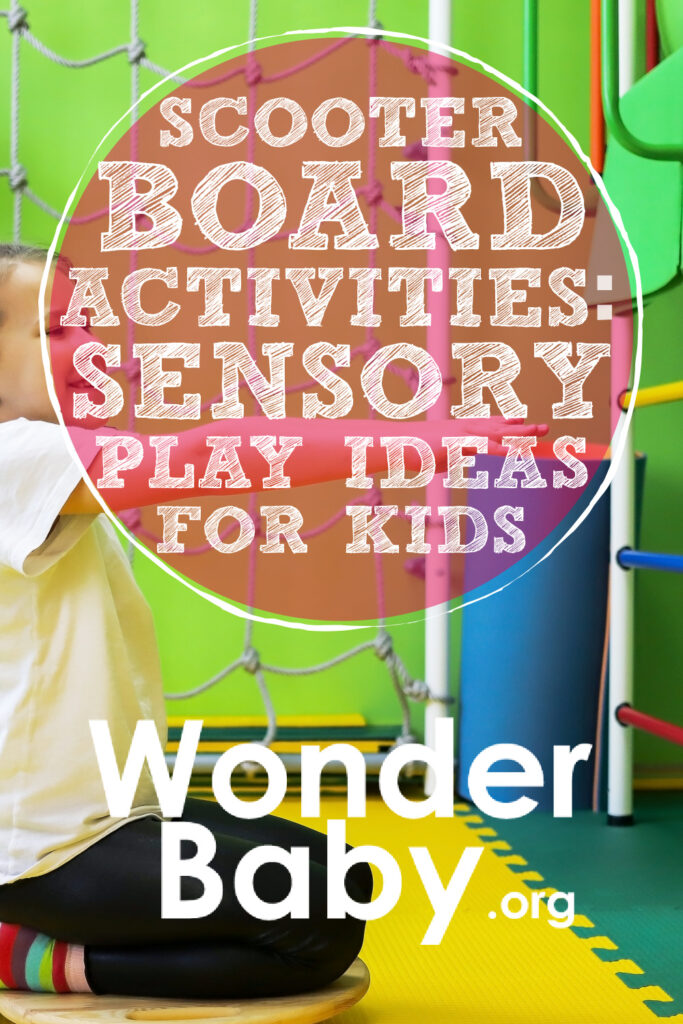
Related Posts
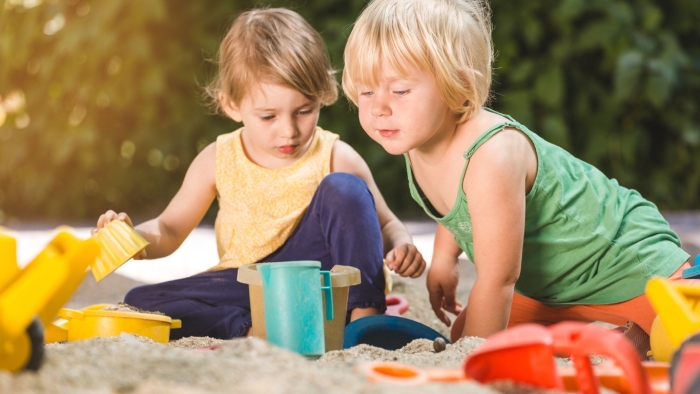
Sensory Activities
5 Sand Play Activities to Encourage Fine Motor Development
Sensory bin, at the beach, or in a sandpit? Try these sand play activities to help toddlers and preschoolers develop their fine motor skills.
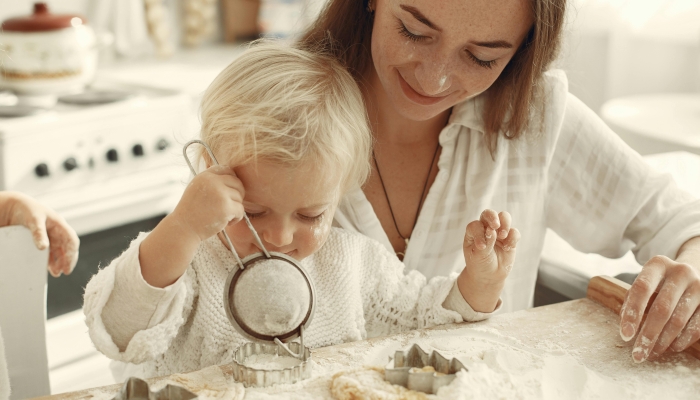
Sensory Activities
5 Edible Sensory Play Ideas
Check out our favorite edible sensory play activities to engage children's senses, boost their development, and provide hours of fun.

Sensory Activities
How to Make Unpoppable Bubbles
Discover the secret to making unpoppable bubbles with this easy guide. You only need three ingredients!
